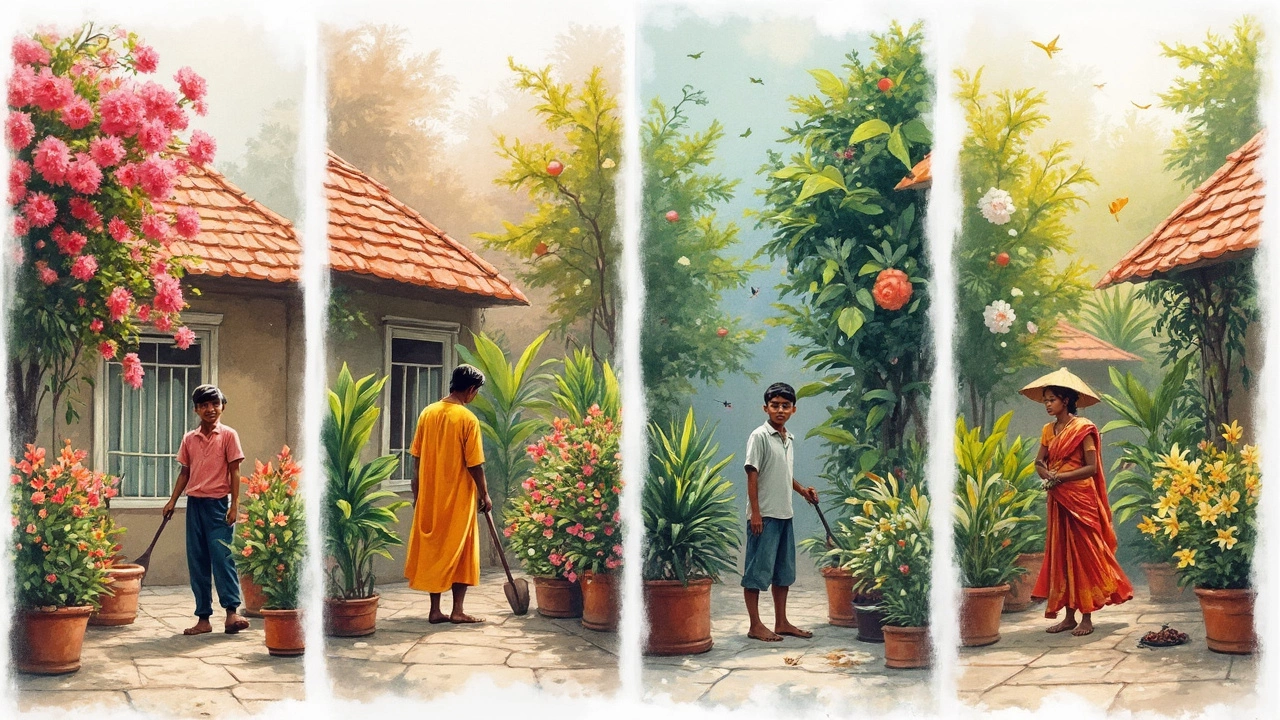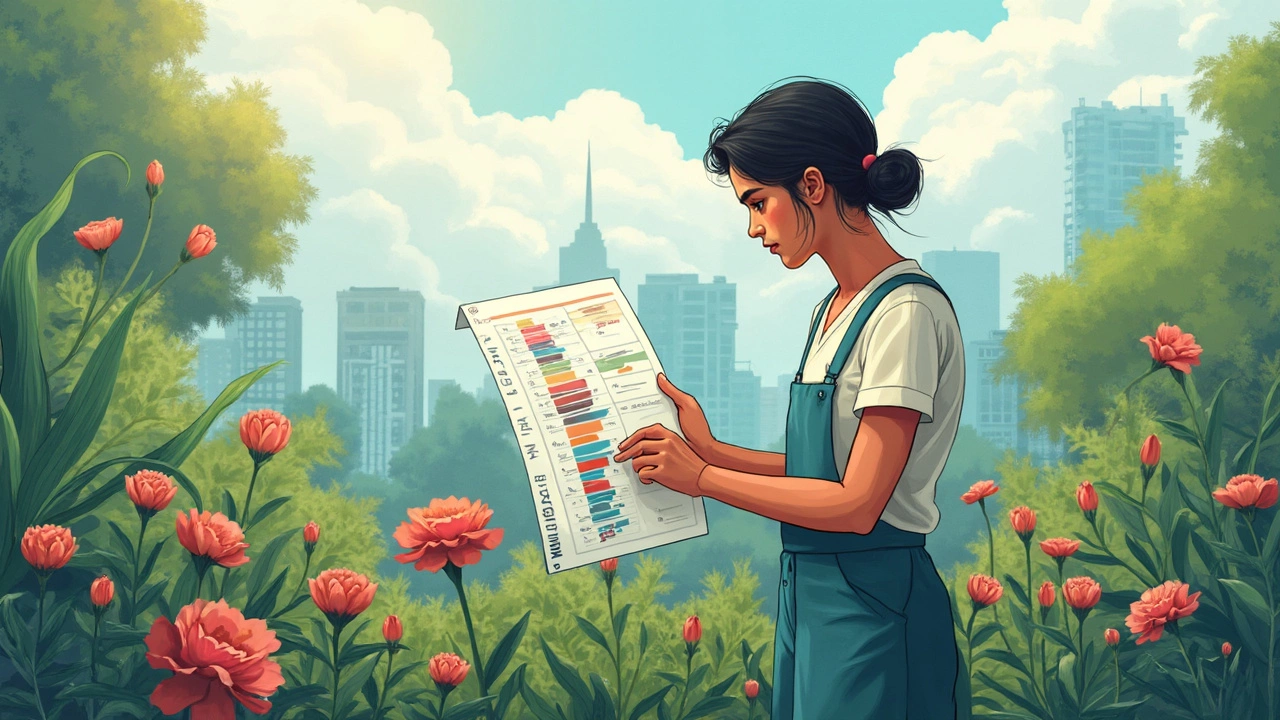Flowers popping open can turn an ordinary garden into something you can't stop looking at. But in India, with its crazy mix of weather and regions, figuring out when exactly those flowers will show up? It actually depends a lot on where you live and the types of plants you grow. You might be surprised that roses and petunias don't share the same blooming month, even in the same city.
If you're hoping to plan a garden that's always got some color, you need to know which months bring out different kinds of flowers. It's not just about guessing or copying your neighbor's backyard. Indian flowers have their own schedule, tied tightly to things like temperature swings, the arrival of the monsoon, and even how chilly the winter gets in your part of the country.
Picking the right months—and the right plants—can mean the difference between endless flowers or frustrating gaps. Let's get into the nuts and bolts of what months you'll actually see blooms, so you can make your own garden plan work with India's seasons, not against them.
- Indian Climate and Flowering Cycles
- Winter Blooms: December to February
- Spring Surge: March to May
- Monsoon Magic: June to September
- Regional Differences and Gardening Tips
Indian Climate and Flowering Cycles
If you want flowers blooming all year in India, you’ve got to think about more than just watering your plants. India has a mix of climates—tropical, sub-tropical, and even a bit of temperate stuff in the North. This blend means the flower blooming India pattern changes from region to region.
Here’s the bottom line: North India gets chilly winters and super hot summers, so winter blooms like marigold and pansies do well there, while tropical flowers show off in the South or along the coasts where it stays warm almost all year. Monsoon season, running from June to September, is a game changer for a lot of Indian gardens. Some flowers love the extra rain, while others sulk and drop buds.
To help you map it out, check this simple breakdown of climate zones and their big flowering windows:
| Region | Main Flowering Months | Popular Blooms |
|---|---|---|
| North India | Dec - Feb (Winter) Mar - May (Spring) | Marigold, Petunia, Rose, Pansy |
| South India | Oct - Mar (Post-monsoon/Winter) Jun - Sep (Monsoon) | Hibiscus, Bougainvillea, Jasmine |
| East/West Coasts | Round the year Peak: Jun - Sep (Monsoon) | Ixora, Zinnia, Cosmos |
While temperature is a huge player, don't ignore rainfall. Monsoon triggers a burst of color in places like Kerala or Kolkata, while dry spells can mess with your garden schedule up North. Humidity and daylight hours also mess with flowering cycles—some plants just won’t cooperate without their perfect combo. A simple tip: look at what’s thriving at the local plant nursery or in public parks around your city each month. It’s the quickest way to know what loves your area’s climate.
If you want a cheat code: most Indian gardens will see marigolds from winter through early summer, hibiscus almost all year in the South, and sun-loving flowers during and right after the monsoon everywhere except in the mountains. Your climate zone is basically your garden’s remote control—use it right and you can have something blooming any month you like.
Winter Blooms: December to February
Indian winters don’t mean a garden without color. These months, especially in the north and central regions, actually see some of the boldest flower shows. The cool air and bright sun help certain plants bloom bigger and last longer. Here’s where things get interesting—your best bet is to focus on "winter annuals." These are flowers you sow just before or during early winter and boom, they steal the show when most shrubs are still snoozing.
Let’s get straight to the point: you’ll see marigolds, petunias, pansies, calendulas, and phlox putting on their best displays from December to February. Roses are another crowd favorite—did you know Indian rose growers time their big shows for Republic Day, January 26th, because that’s peak season?
- Marigolds are probably the most reliable winter bloomers almost everywhere except the coldest Himalayan areas. They’re forgiving if you forget to water them once in a while, too.
- Petunias put out loads of trumpet-shaped flowers, and the colors just go wild during this season.
- Pansies and violas can handle chilly nights and bounce back if the morning’s a bit frosty.
- Calendulas last weeks in the garden or as cut flowers, plus they handle the odd rainy spell.
- Phlox are small, but when you plant enough, they look like a carpet of pink, white, or purple.
Here’s a quick breakdown of top "winter bloomers" and how long you’ll see their flowers:
| Flower | Blooming Period | Best Regions | Sunlight Needs |
|---|---|---|---|
| Marigold | Dec–Feb | All except extreme North | Full Sun |
| Petunia | Dec–Feb (peaks Jan) | North, West, Central | Full Sun |
| Pansy | Dec–Feb | North, Hills | Partial Shade/Full Sun |
| Calendula | Dec–Feb | All zones | Full Sun |
| Rose | Dec–Feb (best Jan) | North, Central, South | Full Sun |
Want the brightest results? Plant seeds or saplings in October or early November. If you’re starting late, go for healthy nursery plants. Another tip: deadhead the faded blooms (just pinch them off), and you’ll get more flowers instead of a garden that looks tired halfway through the season.
The kicker: flower blooming India is at its smoothest in winter if you match your plants to your region’s typical nighttime lows. Bangalore and Hyderabad rarely see a frost, so winter annuals last even longer there. Up North, stick with pansies, violas, and marigolds if you want to play it safe against a cold snap.

Spring Surge: March to May
March to May is when gardens across much of India start showing off. As temperatures nudge up, you'll suddenly notice beds loaded with color—think marigolds, petunias, zinnias, cosmos, and a whole bunch of other "show-off" blooms. This period, called the "spring surge" by local gardeners, is when flower beds really go into overdrive before the heat hits hard.
A lot of things line up this time of year. The chill fades, the days get longer, and just the right mix of sun and mild warmth makes it ideal for tons of flowering plants. Even in tougher zones like Delhi or Lucknow, you’ll see parks and public spaces turning bright with flower blooming India species. Here’s a list of popular blooms you can count on between March and May:
- Marigold (Tagetes species) – super common, easy to grow, flowers last for weeks.
- Petunia – great for planters and beds, found everywhere from balconies in Mumbai to gardens in Chandigarh.
- Zinnia – bold color, likes the warming sun, simple to maintain.
- Cosmos – looks frilly, but handles summer's edge well.
- Phlox and dianthus – lower, bushier flowers that make for dense color patches.
- Gulmohar (Delonix regia) – if you’re in southern or coastal India, these orange-red trees really pop by late April.
Here’s how spring stacks up for flower fans in a nutshell:
| Flower | Best Month To Bloom | Common Locations |
|---|---|---|
| Marigold | March - April | Nationwide |
| Petunia | Late Feb - May | North, Central, and Western India |
| Zinnia | April - May | North, East, cities like Kolkata |
| Gulmohar | Late April - May | South, Coastal India |
| Phlox/Dianthus | March - May | Cooler hill stations |
The best tip? Get your seeds in the ground by late winter or early February. That way, new plants have time to get strong before spring arrives. If you wait until March to start, you’ll end up with short flowering windows—especially if you live where summers get brutal.
“Spring isn’t about rare finds—it’s about picking reliable, sun-loving annuals. If you can water every two days and feed once a month, you’ll have a patch full of color by Holi!” – Anju Suri, Bengaluru-based horticulturist
Keep in mind: in hilly spots like Shimla or Darjeeling, the calendar shifts. Temperatures stay cool longer, so blooms show up a few weeks later. But if you’re in most of India, that March-to-May window is your big chance to enjoy a full floral display before heat and monsoon shake things up.
Monsoon Magic: June to September
This is the time when rain finally hits, and Indian gardens practically explode with color. Those heavy showers between June and September do more than cool the air—they trigger a whole new wave of flower blooming. Monsoon isn’t just about wet ground and green leaves; for gardeners, it’s one of the best seasons for fresh blossoms.
Flowers like hibiscus, rain lilies, cosmos, and balsam love this season. They take advantage of the moist soil and humidity, shooting up with bright, bold blooms. If you want results fast, this is the time to sow seeds for these monsoon-friendly flowers. Also, periwinkle and gaillardia often keep blooming straight through the rain.
R.K. Sawant, horticulturist at the Indian Institute of Horticultural Research, says:
"Indian gardens hit peak diversity during the monsoon. Many varieties flower non-stop, and even new gardeners see rapid growth if they use the rainy months well."
If you’re thinking of starting or revamping a flower patch, plant just before or as the rains begin. Seeds sprout quicker in damp soil, and roots establish stronger because the heat isn’t roasting them. But don’t ignore fungus and pests, which also love a wet season. Choose spots with good drainage and space your plants out so leaves dry after showers.
- Pick fast-bloomers like balsam and rain lilies for quick results.
- Use raised beds or pots if your garden tends to get soggy.
- Add mulch to keep weeds in check and steady the moisture level.
- Watch for snails and fungal spots—remove any affected leaves early.
Here’s a look at some common monsoon bloomers and their usual flowering times:
| Flower Name | First Bloom Month | Peak Bloom |
|---|---|---|
| Balsam | June | July–August |
| Hibiscus | June | June–September |
| Rain Lily | June/after first rains | July–September |
| Cosmos | July | August–September |
| Periwinkle (Vinca) | June | All season |
If you really want your garden to stand out, try mixing colors and heights—cluster short rain lilies under taller hibiscus, so you get a layered look. And remember, flower blooming India calendars always put the monsoon months at the top for sheer variety and volume. Don’t miss out on this natural boost; it’s like getting free gardening superpowers for four months straight.

Regional Differences and Gardening Tips
Gardeners in India know this—what grows like crazy in Delhi might not even survive July in Chennai. India's climate swings between steamy coasts, chilly Himachal valleys, dry Rajasthan plains, and muggy Kolkata afternoons. Because of all this, timing and plant choices change across the map. Here’s how those differences play out if you want your garden to actually bloom, not just survive.
North India, especially cities like Delhi and Chandigarh, see sharp winters and hot summers. Winter flowers like petunias, dianthus, and pansies peak from November to March here. Summers get brutal, so marigolds and sun-loving zinnias stand out. If you’re in the hilly regions—think Shimla or Manali—start sowing seeds indoors or in trays, since frost can wreck seedlings.
Down south, places like Chennai and Bengaluru get milder winters and longer monsoons. Bougainvilleas and hibiscus go wild most of the year. The monsoon (June–September) really wakes up the tropicals—expect lilies and rain lilies to shine. Just remember, too much rain can waterlog your garden, so raised beds or quick-drain pots are smart bets.
Western India (Mumbai, Pune, Goa) feels the monsoon strong and early. Monsoon brings a wave of balsams and cosmos. Soil here can get heavy, so stick to plants that like moisture and don’t freak out in sticky air. Meanwhile, East India (Kolkata, Guwahati) gets bucketloads of rain; try orchids, lotus, and canna—their roots won't mind soggy feet.
This table gives you a quick comparison of common flowering months for popular Indian cities:
| City | Key Blooming Months | Top Bloomers |
|---|---|---|
| Delhi | Nov–Mar | Pansy, Petunia, Marigold |
| Mumbai | Jun–Sep | Balsam, Cosmos, Bougainvillea |
| Bengaluru | Year-round, peak in monsoon | Hibiscus, Rain Lily, Bougainvillea |
| Kolkata | Jun–Sep | Canna, Lotus, Orchid |
Ready to squeeze the most out of your patch? Try these simple tips for flower blooming India:
- Check your local climate, not just the national weather. Small changes matter for flowers.
- Mix perennials (like hibiscus) with annuals (like marigolds) to keep color going all year.
- Start seeds a little before the season starts—the earlier roots, the better the flowers.
- Water early in the morning; late-day watering can attract fungus, especially during humid months.
- Don’t forget to deadhead blooms. Removing spent flowers means fresh ones show up sooner.
- Drench once with organic compost before each major season to give your plants a kick.
Sticking to what grows best in your own yard will always beat chasing trends online. But with some planning, you can get bold colors even when the next street over looks washed out or dry. It’s really all about timing, right plant, and paying attention to where you plant, not just what you plant.

